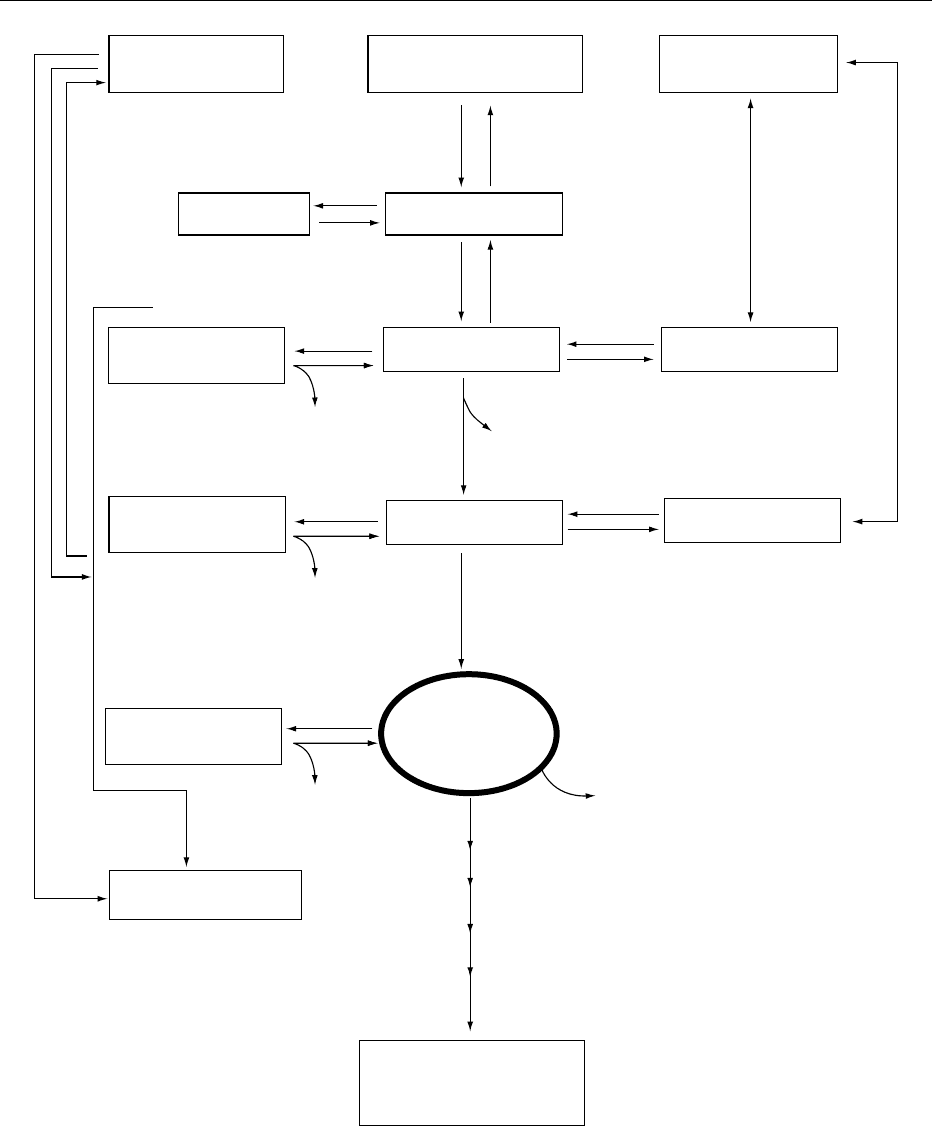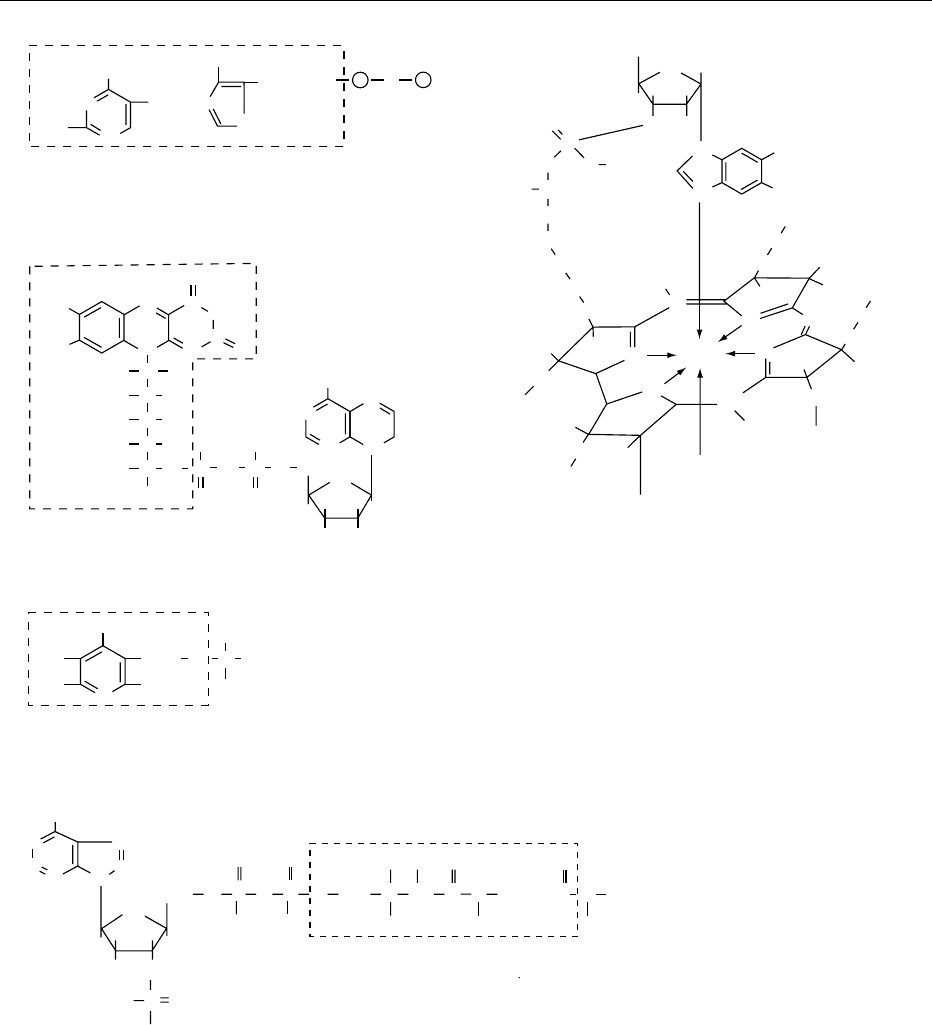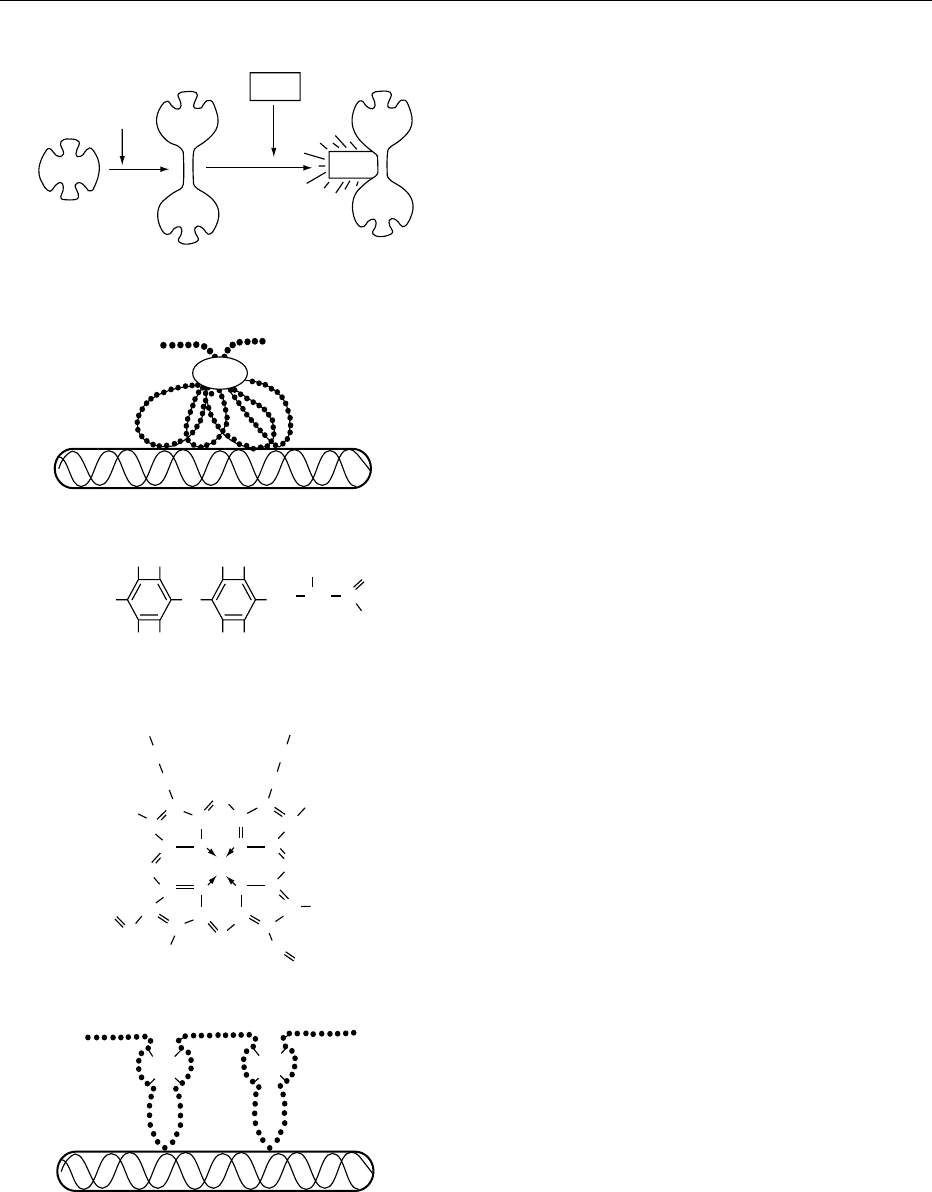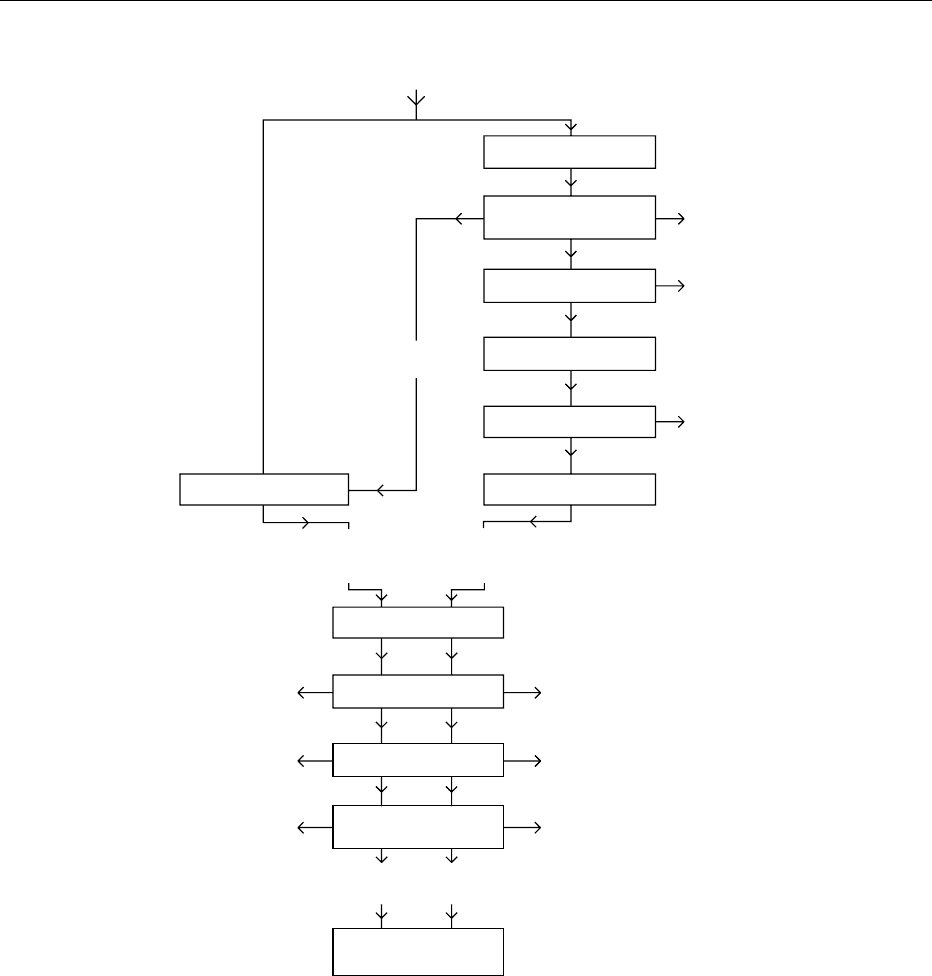Caballero B. (ed.) Encyclopaedia of Food Science, Food Technology and Nutrition. Ten-Volume Set
Подождите немного. Документ загружается.


metabolism is illustrated in Figure 1. Cofactors are
essential in numerous biochemical pathways, includ-
ing the breakdown, or catabolism, of nutrients and
the synthesis, or anabolism, of biological compounds.
The vitamin and mineral cofactors complex with
enzymes to convert nutrients into usable energy and
produce biomolecules that are the basis of life. (See
Minerals – Dietary Importance; Trace Elements; Vita-
mins: Overview.)
Nutrients as Coenzymes and Cofactors
0003 Without the required vitamins and minerals, cofac-
tor-dependent enzymes could not mediate metabol-
ism or maintain normal cell function and biological
processes that are essential for cell division, differen-
tiation, growth, and repair. Nutrient cofactors are
also necessary for the structural integrity of certain
hormones and regulatory proteins.
Vitamins
0004 All of the water-soluble vitamins and two of the fat-
soluble vitamins, A and K, function as cofactors or
coenzymes. Coenzymes participate in numerous bio-
chemical reactions involving energy release or catab-
olism, as well as the accompanying anabolic reactions
(Figure 1). In addition, vitamin cofactors are critical
for processes involved in proper vision, blood coagu-
lation, hormone production, and the integrity of
collagen, a protein found in bones. (See Retinol:
Physiology.)
0005 The active coenzyme form of thiamin, vitamin B
1
,is
thiamin pyrophosphate (TPP) (Figure 2a). TPP is in-
volved in oxidative decarboxylation and transketolase
reactions. An example is the decarboxylation (re-
moval of —COO
--
) of three-carbon pyruvate to two-
carbon acetyl coenzyme A (CoA), an important step in
carbohydrate breakdown. (See Thiamin: Physiology.)
0006 The active forms of riboflavin, vitamin B
2
, are the
coenzymes flavin mononucleotide (FMN; Figure 2b)
and flavin adenine dinucleotide (FAD). These
coenzymes serve as hydrogen carriers for oxidation
reactions that affect energy nutrients in the citric
acid cycle and in the electron transport system. (See
Riboflavin: Physiology.)
0007 The coenzyme forms of nicotinic acid are nicotina-
mide adenine dinucleotide (NAD) and nicotinamide
adenine dinucleotide phosphate (NADP). These com-
pounds assist dehydrogenase enzymes in the catabol-
ism of fat, carbohydrates, and amino acids, and in the
enzymes involved in synthesis of fats and steroids
and other vital metabolites. (See Niacin: Physiology.)
0008 Pyridoxal phosphate (PLP; Figure 2c) and pyridox-
amine phosphate (PMP) are the coenzyme forms of
vitamin B
6
. These are cofactors for approximately
120 enzymes, such as the transaminases, racemases,
decarboxylases, cleavage enzymes, synthetases,
dehydratases, and desulfydrases. Both PLP and PMP
participate in the metabolism of amino acids, includ-
ing transamination, racemization, deamination, and
desulfhydration, and the conversion of tryptophan to
nicotinic acid. (See Vitamin B
6
: Physiology.)
0009Pantothenic acid (PA) is a B vitamin that is a
component of coenzyme A (Figure 2d). Coenzyme A
is necessary for the metabolism of carbohydrates,
amino acids, fatty acids, and other biomolecules. As
a cofactor of the acyl carrier protein, pantothenic acid
participates in the synthesis of fatty acids. (See Osteo-
porosis.)
0010The coenzyme forms of vitamin B
12
are methyl-
cobalamin (Figure 2e) and deoxyadenosylcobalamin.
These assist in the conversion of homocysteine to
the amino acid methionine, the oxidation of amino
acids and odd-chain fatty acids, and the removal
of a methyl group from methyl folate, which regener-
ates tetrahydrofolate. (See Cobalamins: Physiology.)
0011Biotin as the coenzyme biocytin functions in
carboxylation reactions that convert odd-carbon-
numbered amino acids and fatty acids to even-
carbon-numbered compounds, which can then be
metabolized. Biocytin is also necessary for the synthe-
sis of pyrimidines and the formation of urea. Some
holoenzymes containing biotin act as carboxylases to
convert acetyl CoA to cholesterol precursors, and
as transcarboxylases and decarboxylases in other
important reactions. (See Biotin: Physiology.)
0012A coenzyme of folate is tetrahydrofolate (THF),
a carrier of one-carbon units, such as methyl groups
(—CH
3
). One-carbon units arise primarily from the
metabolism of amino acids. They are needed to inter-
convert amino acids and to synthesize purines and
pyrimidines for the formation of RNA and DNA.
(See Nucleic Acids: Physiology.)
0013Vitamin C (ascorbic acid) is a cofactor for the
hydroxylases. Some examples are the hydroxylation
of proline and lysine to create cross-links from intra-
molecular hydrogen bonds that are critical to the
structural integrity of collagen, the hydroxylation of
cholesterol to form bile acids, and the hydroxylation
of tyrosine to form the hormone norepinephrine (nor-
adrenaline). (See Ascorbic Acid: Physiology.)
0014The aldehyde form of vitamin A, retinal, is a cofac-
tor for apoproteins in the eye called opsins. Opsins
are responsible for dim-light vision in the rods (rhod-
opsin) and are involved in color and bright-light
vision in the cone of the retina (iodopsin). When
light strikes the retinal bound to opsin, the conform-
ation of the retinal is changed (photoisomerization)
such that photoreceptor cell membranes are
1476 COENZYMES

Proteins
Glycogen
Carbohydrates
Glucose
Pyruvate
Glucogenic
amino acids
Magnesium
Copper
Magnesium
Manganese
NAD
(nicotinic acid)
TPP (B
1
)
Acetyl CoA
CoA
(pantothenic
acid)
NAD
(nicotinic
acid)
Ketogenic
amino acids
Chromium, zinc
Magnesium,
calcium
Fat
(lipids)
Glycerol
NAD (nicotinic acid)
Magnesium
Magnesium,
sulfur
Fatty acids
Biotin
Magnesium
Manganese
NAD (nicotinic acid)
CoA (pantothenic acid)
NAD (nicotinic acid)
Magnesium
Glucogenic
amino acids
THF
(folic acid)
B
12
(cobalt)
Nonprotein derivatives
(RNA, DNA)
CITRIC
ACID
CYCLE
CO
2
CO
2
NH
3
CO
2
B
6
B
6
NH
3
B
6
NH
3
B
6
Copper
Iron
FMN, FAD (B
2
)
Magnesium
Manganese
NAD (nicotinic acid)
Zinc
ENERGY
(ATP and heat)
CO
2
H
2
O)
Electron transport
fig0001 Figure 1 Overview of carbohydrate, protein, and lipid (fat) metabolism. Vitamins and minerals play crucial roles as coenzymes and
cofactors in both the energy-releasing, catabolic pathways and the anabolic pathways involved in the synthesis of proteins, lipids,
carbohydrates, and nucleic acids. NAD, nicotinamide adenine dinucleotide; TPP, thiamin pyrophosphate; CoA, coenzyme A; THF,
tetrahydrofolate; FMN, flavin mononucleotide; FAD, flavin adenine dinucleotide; ATP, adenosine triphosphate. Reproduced from
Coenzymes, Encyclopaedia of Food Science, Food Technology and Nutrition, Macrae R, Robinson RK, and Sadler MJ (eds), 1993, Academic
Press.
COENZYMES 1477

hyperpolarized and the optic nerve transmits signals
to the brain interpreted as vision. Retinoic acid is the
metabolite form of vitamin A that regulates genes. It
binds to proteins called retinoic acid receptors
(RARs) and retinoid X receptors (RXRs). These pro-
teins are transcription factors belonging to the ster-
oid/thyroid hormone receptor superfamily of proteins
and are found throughout the body. The RAR/RXR
proteins bind to and regulate the transcription of
numerous target genes important for cell develop-
ment.
0015Vitamin K acts as a coenzyme for g-carboxylases,
enzymes that transfer —CO
2
groups. The resulting
carboxylic acid groups are available for calcium
NH
2
CH
2
CH
2
CH
2
CH
3
CH
2
CH
2
O
CH
2
CH
2
CONH
2
CH
2
OH
CH
3
CH
3
CH
3
CH
3
CH
3
CH
3
CH
3
CH
3
CH
2
CH
CH
CO
2
NH
CH
2
CH
2
CH
3
CH
2
CH
CH
CH
NH
2
CH
2
CH
2
CH
2
CH
2
CH
2
CH
3
CH
2
CH
2
CH
2
CONH
2
CONH
2
CONH
2
CONH
2
N
N
S
N
NC
C
N
C
N
H
3
C
3
HC
3
HC
3
HC
H
3
C
H
3
C
NH
2
N
N
N
N
H
3
C
H
3
C
P
P
O
(a)
Thiamin
−
+
NH
O
O
HH
CHOH
CHOH
CHOH
OH
CH
H
O
PO
O
OH
PO
O
HH
H
H
O
OH
POH
OH
O
OH OH
HO
N
H
CHO
(b) Riboflavin
(c) Pyridoxal
O
O
O
CH
CO
O
O
P
HO
H
N
N
C
N
N
N
H
H
H
H
P
P
O
O
OO
O
O
OH
OH
OH
HO
N
N
N
N
N
H
H
H
H
H
H
H
NH
Co
+
(e)
P
OCC
H
O
O
OH
NCH
2
CH
2
C
O
OH
H
NCH
2
CH
2
SH
(d)
Pantothenic acid
fig0002 Figure 2 Selected examples of vitamins as coenzymes: (a) thiamin pyrophosphate; (b) flavin mononucleotide; (c) pyridoxal
phosphate; (d) coenzyme A; and (e) methylcobalamin or coenzyme B
12
. Reproduced from Coenzymes, Encyclopaedia of Food Science,
Food Technology and Nutrition, Macrae R, Robinson RK, and Sadler MJ (eds), 1993, Academic Press.
1478 COENZYMES

binding. Gamma-carboxylation is necessary for the
formation of osteocalcin, a protein important in bone
remodeling, and prothrombin, a coagulation factor
(II) involved in blood clotting (See Vitamin K:
Physiology).
Minerals
0016 Minerals participate as both catalysts and cofactors
in biological reactions. As catalysts, minerals are not
part of an enzyme or substrate, but accelerate the
reaction between the two. As cofactors, they become
a structural component that is essential for the func-
tion of an enzyme or protein. Minerals that play
critical roles as cofactors for enzymes include magne-
sium, manganese, molybdenum, and selenium. Other
minerals, such as calcium, cobalt, phosphorus, and
iodine, act as essential cofactors for nonenzymatic
proteins. Zinc, copper, and iron are cofactors for
both enzymatic and nonenzymatic proteins.
Mineral Cofactors in Enzymatic Reactions
0017 Some examples of how minerals serve as cofactors for
enzymes involved in metabolism are as follows.
0018 Magnesium (Mg) is required as a cofactor for
over 300 enzyme reactions. One critical function is
the stabilization of the structure of adenosine tri-
phosphate (ATP). Energy provided by magnesium-
dependent ATP hydrolysis is required during the
catabolism of carbohydrates (glycolysis and the citric
acid cycle) and fatty acids (b-oxidation) and the an-
abolism of proteins. Magnesium also plays a cofactor
role in enzymes involved in the synthesis of DNA, and
it helps maintain the double helical structure of DNA.
(See Magnesium.)
0019 Manganese (Mn) has been identified as an essential
cofactor in several metalloenzymes. Some examples
are: (1) superoxide dismutase, a mitochondrial
enzyme which catalyzes the breakdown of superoxide
free radicals to hydrogen peroxide and water, thereby
protecting cells from free radical damage; (2) argi-
nase, which helps in the production of nitric oxide
and the urea cycle; and (3) phosphoenol-pyruvate
carboxykinase, which participates in carbohydrate
metabolism. Manganese is also important (but not
essential) in activating the glycosyltransferases,
which are necessary for the formation of glyco-
proteins and proline depeptidase, which catalyzes
the final step in the breakdown of collagen.
0020 Molybdenum (Mb) is a cofactor for several oxida-
tion enzymes. Xanthine oxidase is necessary for the
production of uric acid from purines; sulfite oxidase
converts sulfite to sulfate; and aldehyde oxidase is
involved in the hydroxylation of heterocyclic nitrogen
compounds, such as nicotinic acid.
0021Selenium (Se) functions as a component of enzymes
involved as antioxidants (glutathione peroxidase) and
in thyroid hormone metabolism (5
0
-deiodinases). Al-
though the metal is needed for activity, it is not a
cofactor since it is incorporated in protein as the
amino acid selenocysteine. (See Selenium: Physiology.)
0022Zinc (Zn) is an essential component for more than
100 enzymes. Examples of zinc-containing enzymes
are found in all known classes of enzymes, including
transferases, hydrolases, oxidoreductases, lyases, iso-
merases, and ligases. Zinc is a cofactor in key bio-
chemical reactions in the body, such as carbohydrate,
lipid, and protein metabolism, stabilization of mem-
branes, and synthesis and catabolism of DNA and
RNA. Consequently, zinc is an important contributor
to the processes of replication (synthesis of new
DNA), transcription (synthesis of messenger RNA),
and translation (synthesis of enzymatic and nonenzy-
matic proteins). Some of the general biological func-
tions depending upon the cofactor functions of zinc
include cell replication, tissue growth and repair,
bone formation, skin integrity, and cell-mediated
immunity. (See Zinc: Physiology.)
Mineral Cofactors in Nonenzymatic Molecules
0023Minerals also serve as integral structural components
of a variety of nonenzymatic proteins, as well as for
hormones and vitamin B
12
.
0024Calcium (Ca) functions as a cofactor when it forms
a complex with two structurally related proteins –
calmodulin and troponin C. Calmodulin is a protein
with two globular lobes, each having two binding
sites for calcium (Figure 3a). When calcium ions
bind to calmodulin, a variety of calcium-dependent
enzymes are activated, including membrane phos-
phorylase kinases and some forms of cyclic nucleotide
phosphodiesterases and adenylate cyclases. These
enzymes change the three-dimensional conformation
of the target protein and influence the activity of
signaling pathways whereby cell surface receptors
transmit extracellular signals into cellular responses.
For example, the hormones epinephrine (adrenaline)
and glucagon react with their respective cell surface
receptors to signal the cell to utilize glycogen (the
storage form of glucose). These ‘signals’ induce phos-
phorylation of the enzymes involved in the synthesis
(glycogen synthase) and degradation (glycogen phos-
phorylase) of glycogen.
0025Troponin C is a muscle protein that is structurally
similar to calmodulin. When this protein is activated
by calcium binding, it enhances interactions between
actin and myosin, proteins involved in muscle con-
traction. (See Calcium: Physiology.)
0026Cobalt (Co) is a central atom in the structure of
vitamin B
12
(Figure 2e). This vitamin is essential for
COENZYMES 1479

carbon transfer reactions involved in the synthesis of
DNA and regeneration of methionine. (See Cobalt.)
0027Copper (Cu) ions play a critical role in the structure
of some transcription-regulating proteins. In the pres-
ence of copper ions, certain transcription factors ac-
quire a loop-like structure which forms a cluster close
around the copper ions (Figure 3b). This complex is
called a ‘copper fist’ since it appears to be similar to a
fist clutching a small object. The loop ‘knuckles’ of the
fist are thought to bind to a regulatory region (pro-
moter) of themetallothionein gene. Once the transcrip-
tion factor–copper complex (copper fist) is bound to
the promoter region, another part of the transcription
factor stimulates gene transcription. The translated
metallothionein protein regulates copper levels and
prevents toxicity. (See Copper: Physiology.)
0028Iodine (I) forms part of the thyroid hormones,
thyroxine (Figure 3c), and thyronine. Both hormones
help regulate the basal metabolic rate of organisms.
(See Iodine: Physiology.)
0029Iron (Fe) is a critical constituent of heme (Figure
3d) which forms part of the hemoglobin and myo-
globin molecules. Hemoglobin transports oxygen
to and carbon dioxide away from cells in the body;
myoglobin stores oxygen in muscles. (See Iron:
Physiology.)
0030Phosphorus (P) forms part of the energy-storage
compound ATP. The removal of phosphate (de-
phosphorylation) from ATP to form adenosine diphos-
phate (ADP) releases considerable biochemical energy.
Adding the phosphate (phosphorylation) to ADP to
form ATP again permits the body to store energy. The
storage and release of energy via interconversions of
ATP and ADP is one way the major components of
food (carbohydrates, fats, and protein) ultimately pro-
vide energy for the body. Other types of reversible
phosphorylation help regulate the conformation and
activity of certain proteins such as enzymes.
0031Zinc ions are also needed for the structure of some
transcription factors. The transcription of certain
genes is regulated by DNA-binding proteins that con-
tain important functional domains characterized as
‘zinc fingers’ (Figure 3e). Zinc stabilizes the folding of
the transcription factor into a ‘finger loop’ which is
capable of site-specific binding to double-stranded
DNA. Zinc finger loops are present in the DNA-
binding domains of receptors for glucocorticoids,
mineralocorticoids, estrogen, progesterone, thyroid,
1,25-dihyroxy-vitamin D
3
, and retinoic acid.
Effect of Nutrient Deficiencies
0032A primary deficiency of an essential vitamin or mineral
cofactor is caused by inadequate amounts of the nutri-
ent in the diet. A secondary deficiency occurs because
CN
Calmodulin
(a)
Ca
2+
Ca
2+
Ca
2+
Ca
2+
Cu
2+
Fe
2+
Zn
2+
Zn
2+
Ca
2+
Ca
2+
Ca
2+
Ca
2+
Ca
2+
Inactive
enzyme
Active
enzyme
DNA
(b)
IH
IH IH
IH
HO
O
CH
2
CH
2
CH
2
CH
2
CH
3
CH
2
CH
3
CH
3
CH
CH
2
NH
2
CH
C
C
C
C
C
C
C
C
C
C
C
C
C
C
C
C
C
C
C
N
NN
N
HC
O
OH
(c)
DNA
N
C
COO
−
COO
−
H
H
3
C
H
2
C
H
C
H
C
H
(d)
(e)
fig0003 Figure 3 Selected examples of minerals as cofactors: (a) calmo-
dulin; (b) copper-fist motif; (c) thyroxine or T
4
; (d) heme; and (e)
zinc-finger motif. Reproduced from Coenzymes, Encyclopaedia of
Food Science, Food Technology and Nutrition, Macrae R, Robinson
RK and Sadler MJ (eds), 1993, Academic Press.
1480 COENZYMES

of something other than diet, such as a disease state or
metabolic alteration, which leads to decreased absorp-
tion, impaired transportation, or increased require-
ments, utilization, or excretion. If a deficiency of a
nutrient continues, body stores begin to diminish.
0033 A continued insufficiency of a nutrient cofactor
will impair or inhibit biochemical functions of the
dependent enzyme. The lack of a functional enzyme–
cofactor complex produces an accumulation of the
substrate and a deficit of the enzyme product. At
this point, measurements of biochemical parameters
may indicate a problem that is not yet evident by a
physical examination. This condition is known as a
subclinical deficiency state. Eventually the deficiency
state is developed to the point at which it can be
observed physically and produces the classical clinical
symptoms of a nutrient deficiency.
0034 An example of this process is seen when a dietary
deficiency of iron produces iron-deficiency anemia.
Inadequate dietary intake of the minerals leads to
declining stores in the body. A sensitive clinical test
that measures the amount of the body’s iron-carrying
protein, transferrin, and the amount of iron it is
carrying can detect a developing iron deficiency
before many of the symptoms of anemia are observed.
As body stores continue to be depleted, a lack of
sufficient iron impairs the production of heme, a
prosthetic group necessary for the formation of
hemoglobin in red blood cells. The production of
red blood cells declines and the reduced cell number
can be determined by a simple clinical blood test
called a hematocrit. When the decreased number of
red blood cells cannot transport enough oxygen to
the peripheral tissues, the result is fatigue, a clinical
symptom associated with iron-deficiency anemia.
(See Anemia (Anaemia): Iron-deficiency Anemia.)
See also: Anemia (Anaemia): Iron-deficiency Anemia;
Ascorbic Acid: Physiology; Calcium: Physiology;
Cobalamins: Physiology; Enzymes: Functions and
Characteristics; Iron: Physiology; Magnesium; Minerals
– Dietary Importance; Niacin: Physiology; Selenium:
Physiology; Thiamin: Physiology; Trace Elements;
Vitamin K: Physiology; Vitamins: Overview; Zinc:
Physiology
Further Reading
Berdanier CD (1998) Advanced Nutrition Micronutrients.
Boca Raton, Florida: CRC Press.
Bowman BA and Russell RM (2001) Present Knowledge in
Nutrition, 8th edn. Washington, DC: International Life
Science Institute Press.
Groff JL and Gropper SS (2000) Advanced Nutrition and
Human Metabolism, 3rd edn. Belmont, California:
Wadsworth.
O’Dell BL and Sunde RA (eds) (1997) Handbook of Nutri-
tionally Essential Mineral Elements. New York: Marcel
Dekker.
Shils ME, Olson JA, Shike M and Ross AC (1999) Modern
Nutrition in Health and Disease, 9th edn. Baltimore,
Maryland: Williams & Wilkins.
COFFEE
Contents
Green Coffee
Roast and Ground
Instant
Analysis of Coffee Products
Decaffeination
Physiological Effects
Green Coffee
R J Clarke, Donnington, Chichester, West Sussex, UK
Copyright 2003, Elsevier Science Ltd. All Rights Reserved.
Introduction
0001 Green or raw coffee comprises green coffee beans;
though, in trading practice, it may also contain
small amounts of extraneous matter, derived from
the harvested and processed coffee cherry and other
foreign matter such as stones.
Classification of Green Coffee Beans
0002A green coffee bean, as defined in the International
Standard, ISO 3509–1989 is ‘a commercial term des-
ignating the dried seed of the coffee plant.’ The coffee
COFFEE/Green Coffee 1481

plant or tree (not shrub) belongs botanically to the
Coffea genus in the family Rubiaceae, with subdiv-
isions and some 80 separate species, of which only
two species are commercially important for green
coffee; these are C. canephora (known in the trade
as C. robusta), and C. arabica L. In each of these two
species, there are a number of true botanical varieties,
but also cultivars, developed by horticultural research
and used in plantations for various agronomic advan-
tages. In recent years, a number of interspecies
hybrids have been developed, notably arabusta in
the Ivory Coast, from the crossing of the arabica
and canephora (robusta) species, but also with other
lesser-known species growing wild in the hope of
conferring advantage in respect of disease resistance,
etc. None of these hybrids has yet developed much
commercial success. Two particular ‘original’ var-
ieties of arabica have been generally recognized, C.
arabica var. arabica (syn. var. typica)andC. arabica
var. bourbon. Cultivars are usually intraspecific by
breeding/selection, such as caturra, mundo novo and
catuai in Central/South America amongst the arab-
icas. Varieties in the C. canephora species are less
precise, originally found in Africa; but C. canephora
var. kouillensis is important and planted also in
Indonesia and latterly in Brazil (where it is known
as Conillon robusta); and also C. canephora var.
nganda, especially found in Uganda. Whilst these
varietal/cultivar names are not normally used in the
trade, the different coffee types will contribute, along
with other factors, to differences in flavor quality
(after roasting/brewing).
0003 Genetically speaking, most of the coffee species are
diploid, as is C. canephora, but C. arabica is tetra-
ploid, that is, arabica has 4 11 ¼ 44 chromosomes
in its genome, unlike C. canephora, which has 22.
This phenomenon has given rise to problems in inter-
specific breeding. Arabica plants are self-pollinating,
though they can be crossed, whereas canephora
(robusta) plants are self-sterile and require cross-
pollinating for seed development. Robusta plants
are generally propagated by use of cuttings (Fr.
bouterage), whereas arabica plants are generally
grown from seeds in nurseries, and then trans-
planted. These two species differ in their optimal
environment for growing. Robusta will grow at low
altitudes, will tolerate high temperatures and heavier
rainfalls, and requires a higher soil humus content
than arabica, and is generally more resistant to dis-
eases and pests (hence its common name). Whilst
arabica is grown at higher altitudes (with quality
connotations in respect of height above sea level) the
plants are particularly susceptible to frost damage,
which can occur from time to time, particularly in
Brazil.
0004In general, coffee plants are only grown in those
countries between the tropics. Arabica is generally
believed to have originated in Ethiopia, and was
first cultivated for large-scale export from the
Yemen in about 1600 by the Turks. From the
Yemen, seedlings were transported by Europeans to
other parts of the world, so that it is now found
mainly in Central/South America, and also in India,
Kenya, Tanzania, and other countries. Robusta de-
rives from the rain forests of Central Africa, but was
only really discovered and commercialized from
about 1880. It is now mainly grown in plantations
in West Africa, and also in Uganda and Indonesia.
0005The flavor quality (after roasting/brewing) of ro-
busta is generally considered to be inferior to arabica.
It is certainly less expensive per unit weight of green
coffee, and now constitutes about 25% of the world
trade (imports into consuming countries). Its particu-
lar characteristics have been found favorable in the
manufacture of some instant coffees, but robusta is
also widely consumed as regular brewed coffee in
countries such as France, Italy, and Spain, and often
features in espresso coffees.
0006A further classification of coffee beans relevant to
both arabica and robusta coffee is into (1) flat beans,
a term characterizing the majority of beans produced,
with their single flat side with a central cleft, and (2)
peaberries, which are small rounded beans resulting
from a false embryony within the original cherry. The
latter have a specialty roaster interest, as do so-called
Maragogype, with an abnormally large-size arabica
bean, found in some parts of Brazil.
0007A further basis of classification is described in the
next section.
Green Bean Processing
0008Since coffee is originally harvested in the various
growing countries, as ‘cherries’ or ‘berries’ with a
fleshy interior usually carrying two seeds, and an
outer skin, a sequence of operations is carried out in
those same countries, in order to remove their seeds
and present them as beans (dried seeds) or the ‘clean
coffee’ of commerce. Figure 1 illustrates the sequences.
Removal of Beans from within Coffee Cherries
0009Two procedures have been developed – one, called
dry processing, and the other wet processing (for
washed and pulped coffee). The first, also in historical
order, requires the sun-drying of the coffee cherries
laid out in layers (about 30 mm thick), which need to
be periodically turned over during a period of some 3
weeks, until the moisture content is brought down at
least below 13% w/w. This time period may be sub-
stantially reduced by the alternative use of specialized
1482 COFFEE/Green Coffee

machine air driers. This type of process is used for
nearly all robusta coffee production in the world, but
it is still used for most of the arabica coffee in Brazil
and also in Ethiopia and Haiti. The product is now in
the form of so-called husk coffee, that is, dried coffee
cherries, carrying the dried seeds and all outer
covering, which await the next stages known as
‘curing,’ usually carried out at a central large-scale
curing station, which takes in consignments from
various outlying plantations, both large and small.
In curing, after cleaning, the beans are first separated
from their outer coverings by dehusking machines,
based upon a screw principle, of which there are a
number of commercial designs. The final presentation
as clean coffee is described in a subsequent para-
graph. (See Drying: Drying Using Natural Radiation.)
0010The second procedure, known as wet processing, is
more sophisticated than that of the first. In this pro-
cedure, it is important that the coffee cherries be first
graded for ripeness, preferably by harvesting only
those judged to be ripe and of a red skin color;
water-flotation methods may be used for those
Dry
processing
Drying
Dried
cherry
coffee
Dry
parchment
coffee
Wet
processing
Reception
Flotation
cleaning
Pulping Pulp
Fermentation
Washing
Drying
Mucilage
Stones/
dirt
Harvested
coffee
berries
Floaters
Cleaning
Curing
Hulling
Size grading
Sorting
(density/colorimetric)
Green coffee
(flat beans, peaberries)
Storage
Bagging-off
Husks
Undersize Oversize
Triage/waste Triage/waste
Parchments
(hulls)
fig0001 Figure 1 Flow sheet illustrating the stages of wet and dry processing. Reproduced with permission from Clarke RJ and Macrae R
(1987) Coffee, vol. 2. Technology, p. 2.
COFFEE/Green Coffee 1483

overripe cherries and dried on the tree, but not under-
ripe cherries, which are equally, if not more, undesir-
able. These cherries are then fed into pulping
machines of various commercial designs, which tear
off and separate the skins and fleshy pulps (exocarp
and mesocarp, respectively) in the presence of much
water. Such machines will, however, leave a portion
of the mesocarp, a mucilaginous layer adhering to the
pericarp or a parchment layer directly surrounding
the beans. The next stage in the process is therefore a
means of removal by firstly loosening with fermenta-
tion, which is carried out in tanks. There are variants
of detail of this operation in different countries,
according to local ‘know-how,’ climatic conditions,
and location height above sea level. Fermentation
proceeds through the action of microorganisms or
enzymes from within the semipulped coffee, over a
period of about 24 h under either wet or dry (no
added water) conditions. Care has to be taken that
excess acidity does not develop, nor that of taints.
After a dry fermentation, a water soak has been
recommended (Kenya). The loosened mucilage is
then completely washed off, by use of large quantities
of water as the product is allowed to flow along long
concrete channels, after which it is drained of excess
water. An alternative system to pulping/fermentation/
washing uses the Aquapulper; the manufacturer
claims it will achieve all these operations within one
machine. The resulting product is now known as ‘wet
parchment coffee,’ which has to be dried. Air-drying
is usually practised, that is, the parchment coffee is
laid out on supported trays, with movable coverings
that can be used during the hottest hours of the day,
or again during cold nights. The drying time will be
between 10 and 15 days to reach a desired moisture
content of 11% w/w. Alternatively the parchment
coffee may be machine-dried in a shorter time, or
for part of the time. In either method, great care is
necessary for quality reasons, and optimal conditions
have been the subject of much study in research sta-
tions in Kenya, Colombia, and elsewhere, with many
published papers. It is now necessary to remove the
dry parchment layer to uncover the beans, by hulling
machines similar in principle to those used in the dry
process, already described, though the percentage
amount of dried coverings to be disposed of is clearly
much less.
Preparation of the Clean Coffee for Export
0011 The next stages of curing from either of the two
processes described above, after cleaning, involve
firstly a size-grading stage, that is, by machines with
rotating cylinders on a horizontal axis, fitted along
their length with punched hole screens, of about three
different hole sizes. Size grading is particularly needed
for dry processed coffees (Figures 2 and 3). Each of the
size grades is then subjected to a series of sorting
operations. The first is a density separation, which
enables residual extraneous matter originating from
the cherry, such as pieces of husk, parchment, etc.
(dependent upon the wet or dry process previously
used), abnormally light density beans, and indeed of
foreign matter, to be removed as much as possible.
Separation methods generally rely on air levitation
principles, for which a number of machine types are
available. A second sorting based upon the color of
beans has traditionally relied upon hand-picking as the
beans move along a traveling belt, which also enables
some other defects such as malformed beans and other
residual defective matter to be removed. Electronic
sorting is, however, becoming very widely used, with
monochromatic light used to sort out, in particular,
‘black beans,’ regarded as especially unfavorable to
quality, which may otherwise occur frequently in dry
processed coffees. The target is to achieve substan-
tially less than 1% by weight of black beans (or
fewer than five per 300 g sample). Electronic sorting
may also use multichromatic light, which enables a
wider range of discolored beans to be discarded,
though such sophisticated machines are more usual
in the consuming countries. For wet processed arab-
ica there has also been a considerable growth in the
8.00(20)
7.50(19)
7.10(18)
Grade II
Grade I
Grade III
6.70(17)
6.30(16)
6.00(15)
5.60(14)
5.00(13)
4.75(12)
4.00(10)
20 50
Cumulative amount retained on screen by weight (%)
Aperture diameter (mm) (screen number)
94 99
fig0002Figure 2 Typical screen analyses for different size grades of
Ivory Coast robusta green coffee beans according to specifica-
tions (including allowable tolerances), plotting percentage cumu-
lative amount by weight (probability scale) held at each screen
size (aperture diameter, mm) for screens according to ISO 4150.
o—o, actual experimental data for grade II sample. Reproduced
with permission from Clarke RJ and Macrae R (1987) Coffee,
vol. 2. Technology, p. 41.
1484 COFFEE/Green Coffee

use of sorters, in the producing countries, based upon
fluorescence differences, which are designed to
remove any so-called ‘stinker beans,’ difficult to
detect easily otherwise but especially undesirable to
flavor quality if present, even in very small numbers.
0012 The object of all the foregoing stages is therefore to
provide ‘clean coffee’ at the right moisture content,
which can then be bagged for export (or internal
consumption) and documented according to origin,
type, and grade. Commercial green coffees are further
subdivided into wet-processed arabicas, known as
‘milds’ in the trade, dry-processed arabicas, and
robustas (dry-processed).
Marketing, Grades, Shipping, and Storage
0013 The marketing of coffee is a complex commercial
operation, with an underpinning by the International
Coffee Organization, based in London, which, for
example, through international governmental agree-
ments in force from time to time can organize quota
systems for price stability. For the various green
coffees under their control for export, the marketing
authorities in different countries issue specifications,
which may be either detailed or brief, without neces-
sarily direct reference to flavor (i.e., when roasted/
brewed). Test methods are available, many from the
International Standards Organization on representa-
tive samples from consignments.
Grades and Types of Green Coffee
0014An important grade criterion is that of bean size
(range), as can be characterized by a screen analysis
using a number of internationally recognized screens
with specific hole diameters (ISO 4150–1980, revised
1991). Different shorthand terms are used to express
bean size distribution, e.g., letters such as A, B, C,
etc., in Kenya, words (large–small with intermedi-
ates) in Brazil, and numbers (1, 2, 3) in robustas
from the Ivory Coast. From Colombia, virtually
only one size grade (excelso) is exported, all defined
on screen no. 15 (6 mm) and most through no. 18
(7.5 mm hole diameter).
0015A second criterion is that of type, specifically de-
fining the number of defects present per sample, that
is, defective beans of various kinds, extraneous and
foreign matter. Different systems are in force, though
most adopt a black bean equivalency system, where
one black bean per 300-g (or 1-1b) sample equals one
defect, and where other kinds of defect are assessed as
numbers required to equal one black bean. Total
numbers of defects define the type, which may be
expressed in words, e.g. supe
´
rieure in the Ivory
Coast for robusta, or terms, e.g. NY numbers (1–8)
in Brazil. Such type numbers are not, however, used
for wet-processed coffees from Kenya, Colombia, and
some other countries, where the number of defects in
most of their exported coffee is very small (e.g., < 13
per 300-g or 1-lb sample). Numbers of particular
defects such as moldy or insect-damaged beans
are rigorously controlled in many countries (both
importing/exporting); especially in the USA by the
Federal Drug Administration with legislative backing,
primarily for health and hygiene reasons.
0016A specification will, of course, refer to country of
origin, maybe also growing area/port of embarkation
and species/green bean processing method where this
may be otherwise uncertain; and whether new crop or
old crop. Purchase or otherwise may be primarily on
the basis of exchange of samples, where the oppor-
tunity of inspecting for flavor quality and appearance
is available.
Shipping and Storage
0017Some storage of green coffee is inevitable at various
times from source to roaster, including of course
during transit by ship (whether in bags in holds, or
now more usually bags or loose in containers). It is
generally recognized that green coffee should not be
allowed to reach a moisture content in excess of 13%
w/w; otherwise, mold growth will start to occur,
which increases rapidly with increasing moisture con-
tent, causing flavor deterioration and the possibility
of mold toxin formation. It should be noted that
Bold − Large
Good − Bold
Medium − Good
Medium
Small
Good
8.00(20)
7.50(19)
7.10(18)
6.70(17)
6.30(16)
6.00(15)
5.60(14)
5.00(13)
4.75(12)
4.00(10)
1102045
Cumulative amount retained on screen by weight (%)
Aperture diameter (mm) (screen number)
70 90 98
fig0003 Figure 3 Typical screen analyses for different size grades of
Brazilian arabica green coffee beans according to specifications
(including allowable tolerances). Percentage cumulative amount
by weight held at each screen size (screens according to ISO
4150) plotted on a probability scale. Reproduced with permission
from Clarke RJ and Macrae R (1987) Coffee, vol. 2. Technology,
p. 43.
COFFEE/Green Coffee 1485
